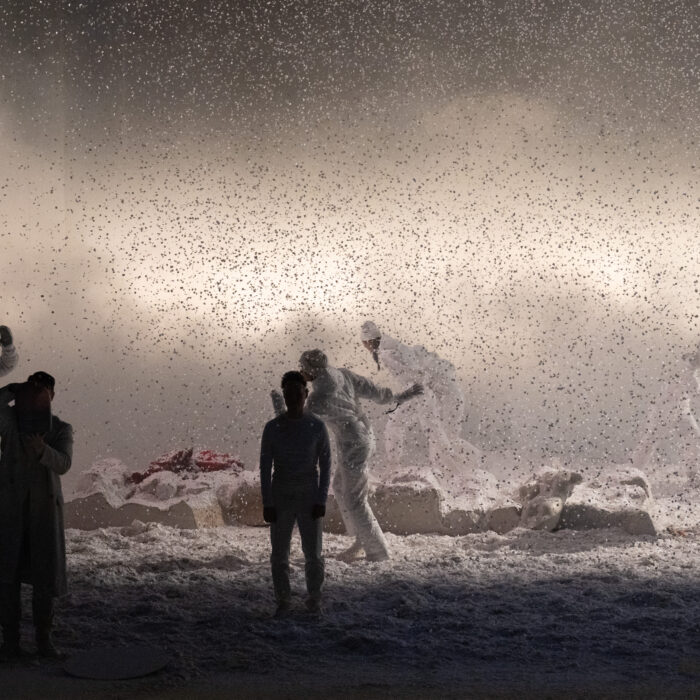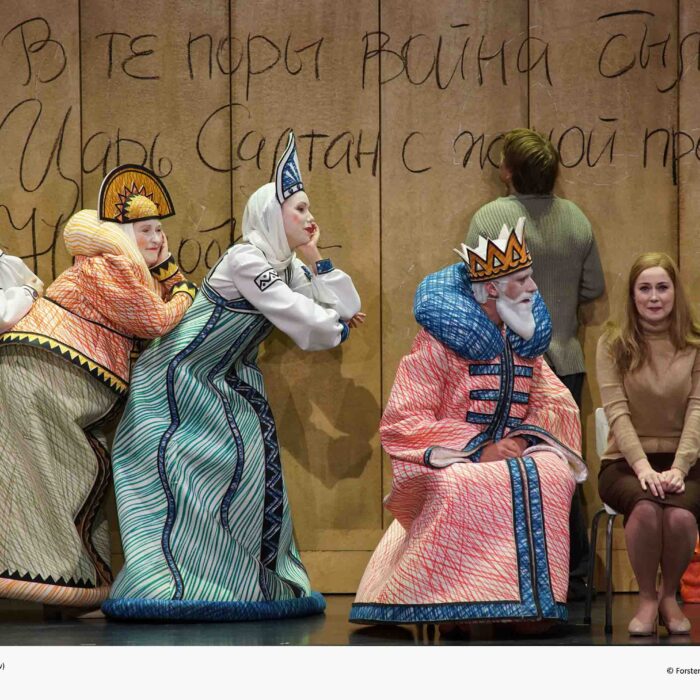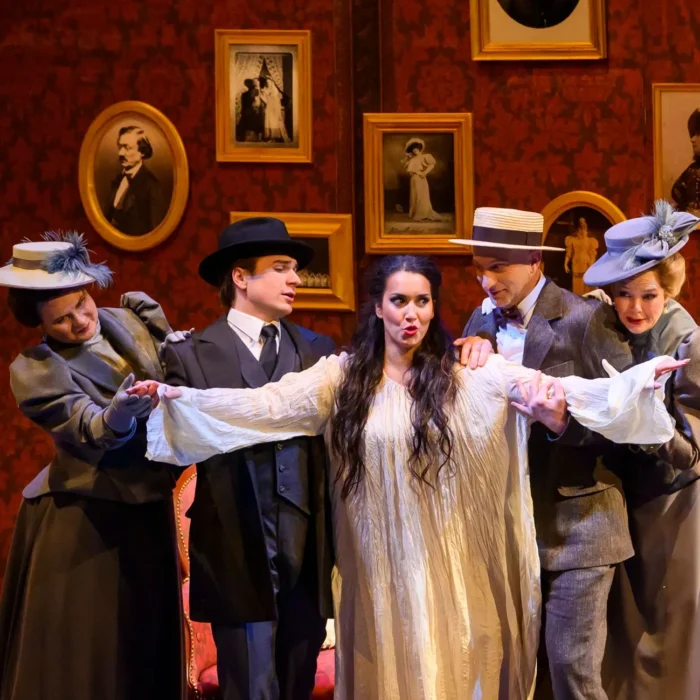
Opera Meets Film: Opera Is Life in Kevin Sullivan’s ‘Magic Flute Diaries’
By John VandevertReleased in 2008, Canadian director Kevin Sullivan’s reimagining of “The Magic Flute” in his film, “Magic Flute Diaries,” was a profound statement on the way operatic narratives could be fused into the real world through a cross-relationship of experience, emotion, and feeling.
Starring Canadian soprano Mireille Asselin as Masha/Pamina and baritone Olivier Laquerre as Papageno, the film continued the trend of “Magic Flute” adaptations begun in the mid-1970s with Ingmar Bergman’s film. Centered around the production of “The Magic Flute” to celebrate Mozart’s 250th birthday, the love story between Tom (Warren Christie) and Masha goes in and out of reality, suffusing a fantasy realm into reality and rendering our own understanding of life in an equally obscured manner. The way Sullivan described the film was one where the opera was recast as the “backstory” to the challenging dynamic between Tom and Masha, and in many respects, opera has always done this.
From Giuseppe Verdi’s many politically-minded operas like “Nabucco,” “Don Carlos,” and “I Lombardi alla Prima Crociata,” to the many contemporary operas of topical relevance like Alexander Raskatov’s “Animal Farm“ (2022) and Mihai Valcu’s “Katharina von Bora“ (2015), opera has always been intimate with life. However, what film gives this relation is a continued deepening by which operatic life can synthesize into experiences of non-operatic life.
It’s no surprise that the (get ready…Johannes Chrysostomus) Wolfgangus (Theophilus) Mozart’s “Magic Flute,” noted as one of the world’s most recognized operas in the canon today among the general populace, has been one of those select operas which, cinematically, has had its share of attention. The iconic 2006 film by Kenneth Branagh, hallmarked by the Queen of the Night’s entrance (performed by Lyubov Petrova) on top of a WWII tank, marked the first time I was exposed to the joys of cinematic opera. Of course, other iconic operatic cinema like Żuławski’s “Boris Godunov” (1989), Zeffirelli’s “Pagliacci“ (1982), Jacquot’s “Tosca“ (2001), and Dornhelm’s “La Boheme“ (2008), have made their mark on opera’s “cinematic turn,” and the wider trend of filmed operas.
But while the topic of operas in cinema is interesting, a justly in vogue topic nowadays, thanks to the push for greater levels of accessibility and adoption by houses like the Metropolitan Opera, I instead want to talk about opera (plots/music) as/in a window into life. The presence of operatic repertoire in cinematic projects is extensive, the use of Wagner’s music one particularly notable example, and when opera is used, just as Werner Herzog expressed in his autobiography, the potency of operatic music is the unique way emotion is shown. As he wrote,
[…] the heightened emotional world of opera is absolutely sui generis [of its own class]; it doesn’t exist in human life or in nature. Feelings in opera are compressed and intensified, but for the audience they are real because the power of the music makes them so. Feelings in grand opera are like principles of feelings, like axioms in mathematics, incapable of further reduction, concentration, explanation.
Perhaps the reason opera has and continues to be such a popular topic for cinematic interpretation, along with operatic repertoire being featured in non-opera specific films, is the ineffable quality it brings to a cinematic universe, where the human expressions of emotion is enhanced to a degree that feels sublime, if almost entirely foreign to the mundanity of the non-operatic everyday. The sheer amount of films about opera (e.g., The Glass Mountain, 1949; Melba, 1953), featuring opera (e.g., The Cat Above and the Mouse Below, 1964; Champagne Waltz, 1937), or which reconceptualize operatic repertoire (e.g., Lessons of Darkness, 1992), suggests something unique about the art form. While biopics and biographical dramas have been around forever on classical music composers and performers, from Mozart and Wagner to Callas and Caruso, so too have films which extend the operatic art form into the world of cinema. Some of the earliest experiments come from the 1910s, two examples being D. W. Griffith’s “The Birth of a Nation“ (1915) and Samuel Goldwyn’s failure, “Thais“ (1917).
From here, an entire movement was reinvigorated which brought operatic narratives even closer to our lived experiences, destabilizing the distance between the opera world and our own. In other words, through film, operatic plots, narratives, and challenges could continue blurring into our own life. What we see (on stage, on screen) is a heightened form of our personal analogues, and in Kevin Sullivan’s film, this certainly seems the case.
It’s helpful to dip into some more cinematic opera history, as this notion of cinematic adaptations and usage of opera in the extension of experiences, love stories, and plots almost defines the very genre itself. In the 1910s, the trend of films on plots of operas began, some of the earliest being J. Gordon Edwards’s “The Song of Hate“ (1915, lost) and Phillips Smalley and Lois Weber’s “The Dumb Girl of Portici“ (1916). During the following decades and into the evolving present, an almost overwhelming torrent of films were made on real-world topics fused into fictional worlds and melded together by opera. Across the many folds of opera’s canonical and non-canonical works, directors from around the world began using opera in eclectic manners, from satirical meta-productions (A Chorus of Disapproval, 1989), fictional forms of love based on operatic models (Falling for Figaro, 2021), statements of nationalistic pride (Háry János, 1941), and even Hollywood-based attempts at immortalization (Maria, 2024).
The point is that when opera is used in film, it can range in many different forms but in all forms, there is a synthesis of lived experience into the music and plots of opera which both compliment and extend them in turn. This type of life/art merger is why I first became interested in opera in film, and while less known today, Sullivan’s film was one landmark example of how opera can take the tumults of life and render it permanently changed by the power of artistic imagination. Now it’s your turn to discover the wonders of the cinematic opera universe, one film at a time.


